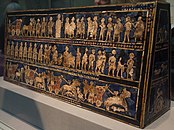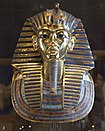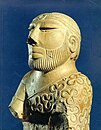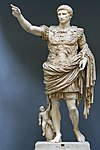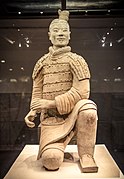
Back Altertum ALS Edat Antiga AN التاريخ القديم Arabic Edá Antigua AST Qədim Dünya Azerbaijani قدیم تاریخ AZB Oitadum BAR Senuobės istuorėjė BAT-SMG Старажытны свет Byelorussian Èlmu perkolotan BEW
| Ancient history |
|---|
| Preceded by prehistory |
|
| Part of a series on |
| Human history |
|---|
| ↑ Prehistory (Stone Age) (Pleistocene epoch) |
| ↓ Future |
Ancient history is a time period from the beginning of writing and recorded human history through late antiquity. The span of recorded history is roughly 5,000 years, beginning with the development of Sumerian cuneiform script. Ancient history covers all continents inhabited by humans in the period 3000 BC – AD 500, ending with the expansion of Islam in late antiquity.[1] The three-age system periodises ancient history into the Stone Age, the Bronze Age, and the Iron Age, with recorded history generally considered to begin with the Bronze Age. The start and end of the three ages vary between world regions. In many regions the Bronze Age is generally considered to begin a few centuries prior to 3000 BC, while the end of the Iron Age varies from the early first millennium BC in some regions to the late first millennium AD in others.
During the time period of ancient history, the world population was already exponentially increasing due to the Neolithic Revolution, which was in full progress. While in 10,000 BC, the world population stood at 2 million, it rose to 45 million by 3000 BC. By the Iron Age in 1000 BC, the population had risen to 72 million. By the end of the ancient period in AD 500, the world population is thought to have stood at 209 million. In 10,500 years, the world population increased by 100 times.[2]
- ^ Stearns, Peter N. (2017). "Periodization in World History: Challenges and Opportunities". In R. Charles Weller (ed.). 21st-Century Narratives of World History: Global and Multidisciplinary Perspectives. Palgrave. ISBN 978-3-319-62077-0.
- ^ Data Archived 10 December 2019 at the Wayback Machine from History Database of the Global Environment. Archived 27 February 2018 at the Wayback Machine K. Klein Goldewijk, A. Beusen and P. Janssen, "HYDE 3.1: Long-term dynamic modeling of global population and built-up area in a spatially explicit way", from table on p. 2, Netherlands Environmental Assessment Agency (MNP), Bilthoven, The Netherlands.
